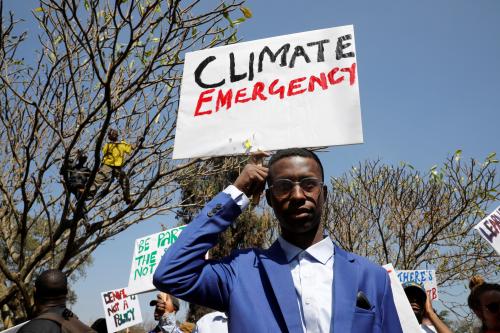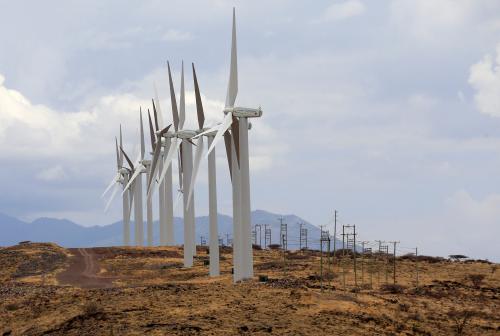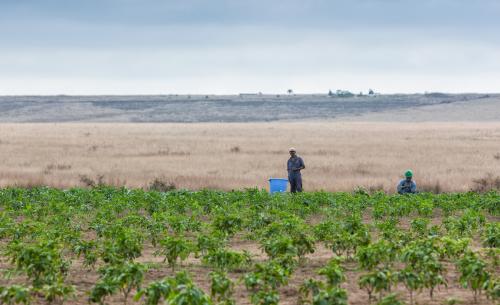As the COP26 meetings ended on Sunday, it quickly became clear that the region that will suffer the worst economic and social effects of rising temperatures—and that can least afford to cope with challenges climate change will bring—gained very little in Glasgow. Little agreement was reached on how to compensate African countries for the damage that centuries of fossil fuels and other emissions in rich countries will have on Africa’s development prospects owing to the current and future effects of climate change. The unfairness of the current situation—where today’s rich countries reached the highest levels of material welfare the world has ever seen primarily by harnessing cheap energy from fossil fuels, but most of the negative consequences of this strategy will fall on the world’s poorest countries—demands compensatory financing from the Global North to the Global South, especially Africa.
Yet, no agreement was reached on this pressing issue during two weeks of negotiations. The costs of failure of action, and the stark choices African countries will face, are daunting. Indeed, as laid out in the report “State and Trends in Adaptation Report 2021: Africa,” the challenges for the private, public, and nonprofit sectors, as well as for farmers, the informal economy, and formal firms, are great—at both the macroeconomic and microeconomic levels. They will affect people in rural areas, small towns, and cities, in drylands and in areas where flooding will increase, threatening the provision of health, education, and other services. In the end, as I recently explored in a chapter in that report, the biggest losers from a lack of agreement are Africa’s youth, who will suffer the most from the effects of man-made climate change.
Mitigation vs. adaptation
Most of the focus in Glasgow was on mitigation (prevention of further temperature increases). Indeed, agreement was reached during COP26 on some key mitigation measures, including the need to reduce methane emissions, reliance on fossil fuels for energy generation, and deforestation—in both rich and poor countries. Recognizing that poor countries could not undertake the needed investments on their own, rich countries had already agreed back in 2009 to provide concessional financing and grants to help low- and lower-middle-income countries to build this new infrastructure—in other words, mitigation financing. However, this commitment remains unrealized: As noted in the communique, countries had not “yet” met the targeted amount, $100 billion by 2020.
Even if global mitigation measures work and temperatures stop rising at some point during this century, African countries will still experience negative effects, starting now, at least until 2050.
But preventing a worsening of future global climate risks by reducing emissions in Africa—the region that emits the least—hardly changes the equation for Africa. The real problem for Africa is now. Even if global mitigation measures work and temperatures stop rising at some point during this century, African countries will still experience negative effects, starting now, at least until 2050. Countries need to adapt their development strategies and investments now, especially because climate change and the need for adaptation will raise the cost of achieving all development strategies and goals for the foreseeable future. Needed adaptation to climate change will cost money, much more money than the $100 billion pledged for mitigation investments. While mitigation investments in Africa could have long-term payoffs (e.g., in the last half of this century) if they do succeed in slowing down or halting rising temperatures, adaptation investments are needed now.
Why these choices matter for youth
Africa’s children and youth, including those just born, will bear the costs of climate change. Half of Africa’s population is under the age of 20. This group will suffer both the direct effects (e.g., severe weather disasters) and the indirect effects—the lost opportunities from needed investments in other areas that will not be made because public and private funds will have to be spent on adaptation. The infrastructure Africa badly needs will cost more because it will have to be more weather-resistant (otherwise it will break down more often, reducing benefits). African agricultural research and development will have to up its game dramatically to avoid declines of up to 30 percent in land and labor productivity. As a result, African countries will have less public money available for other priorities, such as education, health, and nutrition. Investment in productive capacity will cost the private sector more too, slowing down growth and transformation. The result will be lower earnings and increased poverty. The youth of 2030 (ages 5-14 today) will reach their expected peak earnings period by 2045, when the worst economic effects will be felt—up to an 80 percent decline in income growth (about 4 percent per annum) compared to today. This long-term income damage will substantially affect their and their children’s future.
Adaptation policies and investments, if started today, could prevent the worst aspects of this grim future. But even if additional funding for adaptation investments is secured, countries will still face difficult choices and trade-offs, including how much to invest in adaptation now versus building human capital for future earnings growth and to better cope with future challenges. Despite being the most educated generation ever in Africa, African youth have not shown the level of engagement on climate change shown by youth in other countries, in part because of pressing urgent needs, and in part owing to political exclusion in some countries. Yet countries will be making key decisions soon. African youth should be consulted and effectively engaged both in early-stage investment decisions and monitoring local outcomes.






Commentary
Africa’s youth lost out in Glasgow
November 18, 2021